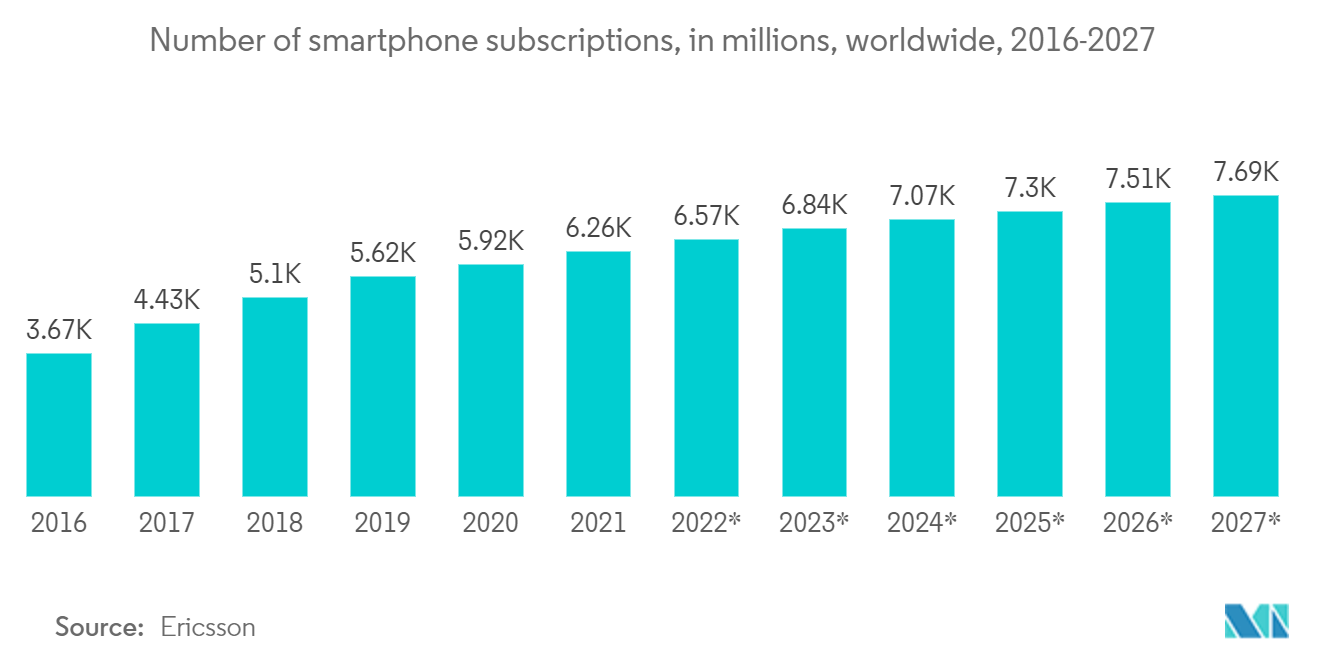Market Trends of GNSS-Enabled Consumer Device Industry
This section covers the major market trends shaping the GNSS-Enabled Consumer Device Market according to our research experts:
The Smartphones Segment is Expected to Considerably Drive the Market's Growth
Despite considerable saturation of mature markets, such as EU28, North America, and China, for smartphones, the shipments of smartphones still outnumber devices using GNSS chips. Smartphones have been using GNSS chips for a considerable time. In most cases, these chips support all publicly available satellite networks, such as GPS, GLONASS, Galileo, etc. However, when compared to dedicated navigation devices, these solutions were less accurate.
Additionally, a degree of monopoly in the smartphone hardware market limited the scope for GNSS chip installations. Qualcomm hardware usually does not include Broadcom GNSS chips and vice versa, as they are prime competitors. But in recent years, this scenario has been changing. Moreover, the European Commission has approved a regulation mandating that new smartphones launched in the market will have to include satellite and Wi-fi location services. According to the regulation, chipsets enabled with the Global Navigation Satellite System (GNSS) capabilities will likely have access to the EU's satellite system Galileo, which provides accurate positioning and timing information. Eight EU countries have been following this regulation and are using Galileo-compatible chipsets.
According to the European GNSS Agency, over 95% of the satellite navigation chipset supply market supports Galileo in new products, including various manufacturers of smartphone chipsets like Broadcom, Qualcomm, and Mediatek. With leading GNSS chipset providers producing Galileoreadychipsets and global smartphone brands already integrating these chipsets in their latest smartphone models, the market is expected to have further growth opportunities in the forecasted period.
Further, according to Google, more than 1 billion fixes per day from pedestrians' smartphones in cities are on the wrong side of the street or the wrong city block. In 2021, Broadcom launched a new solution that significantly improves accurate walking navigation by combining the Broadcom dual-frequency GNSS BCM47765 chip and a new Android service that provides GNSS assistance through complex GNSS reflection ray modeling using their 3D building models.
Since the release of Android 7.0, raw GNSS measurements tracked by smartphones operating with Android can be accessed. These GNSS observations can be used directly to estimate the user position with specialized self-developed algorithms and correction data. Since smartphones are equipped with simple, cost-effective GNSS chips and antennas, so they provide challenging, low-quality measurements. Furthermore, most smartphones offer GNSS measurements on just one frequency.
Precise Point Positioning (PPP) is one of the most promising processing techniques for Global Navigation Satellite System (GNSS) data. The technique is characterized by using precise satellite products (orbits, clocks, and biases) and applying sophisticated algorithms to estimate the user's position. In contrast to relative positioning methods, PPP does not rely on nearby reference stations or a regional reference network. Furthermore, PPP is very flexible, which is another advantage considering smartphones' challenging nature of (single frequency) GNSS measurements.

The Asia-Pacific Region is Expected to Witness a High Market Growth
In March 2021, China rolled out its 14th five-year plan; it is a plan touching on all aspects of development over the next five years and presenting China's 2035 vision. The 14th Five-Year Plan's persistent emphasis on R&D and innovation substantially impacts China's GNSS industry. "Deepen the promotion and use of BeiDousystems; Promote the industry's high-quality growth" is advocated as a policy guideline in the plan as an important national strategic project. The strategy is expected to signify a boost in GNSS industry research and development, the promotion of BeiDou'sindustrial application, and the acceleration of important core technology advancements.
The GNSS & LBS Association of China (GLAC) presented a White Paper on the Development of China's Satellite Navigation and Location Services Industry (2021) on May 18, 2021, in Beijing, summarising the GNSS industry's development in 2020. According to the White Paper, the overall output value of China's satellite navigation and location services business reached CNY 403.3 billion (about USD 62.75 billion) in 2020, up 16.9% from 2019.
The firms in the region are incorporating new features in the existing products or developing new products to meet the wide needs of the customer. For instance, in April 2022, The P300 Series GNSS Tablet was offered to the global market by ComNavTechnology. The high-precision GNSS in-cab Android rugged tablet, based on the K8 platform, delivers extreme, industry-leading performance and ease of use to precision agriculture, autonomous driving, machine control, and other industries. The P300 series GNSS tablet, which is equipped with a new generation K8 OEM module, can track all current and planned constellations (including GPS, BeiDou, BeiDouGlobal, GLONASS, Galileo, and QZSS) and achieve centimeter-level precision. The P300 series GNSS tablet uses advanced QUANTUMTM III technology in conjunction with an upgraded SinoGNSSASIC chip and advanced Microprocessor unit to provide improved heading and positioning performance for everyday field use.
Furthermore, in December 2021, MediaTek announced device maker acceptance and endorsements from some of the world's leading smartphone brands, including OPPO, Vivo, Xiaomi, and Honor, for its Dimensity9000 5G smartphone chip for next-generation flagship smartphones. The first flagship smartphones powered by the Dimensity9000 will hit the market in the first quarter of 2022. Because the processor supports the newest Wi-Fi, Bluetooth, and GNSS standards, smartphone users can experience seamless communication.
Since introducing information and mobile phone technologies, various countries have relied heavily on PVT-based applications. Currently, four GNSS systems are available worldwide: GPS from the United States, GLONASS from Russia, Galileo from the European Union, and BeiDoufrom China. Also, NavICfrom India and QZSS from Japan are two regional navigation satellite systems that provide navigation signals for the stated coverage area.


